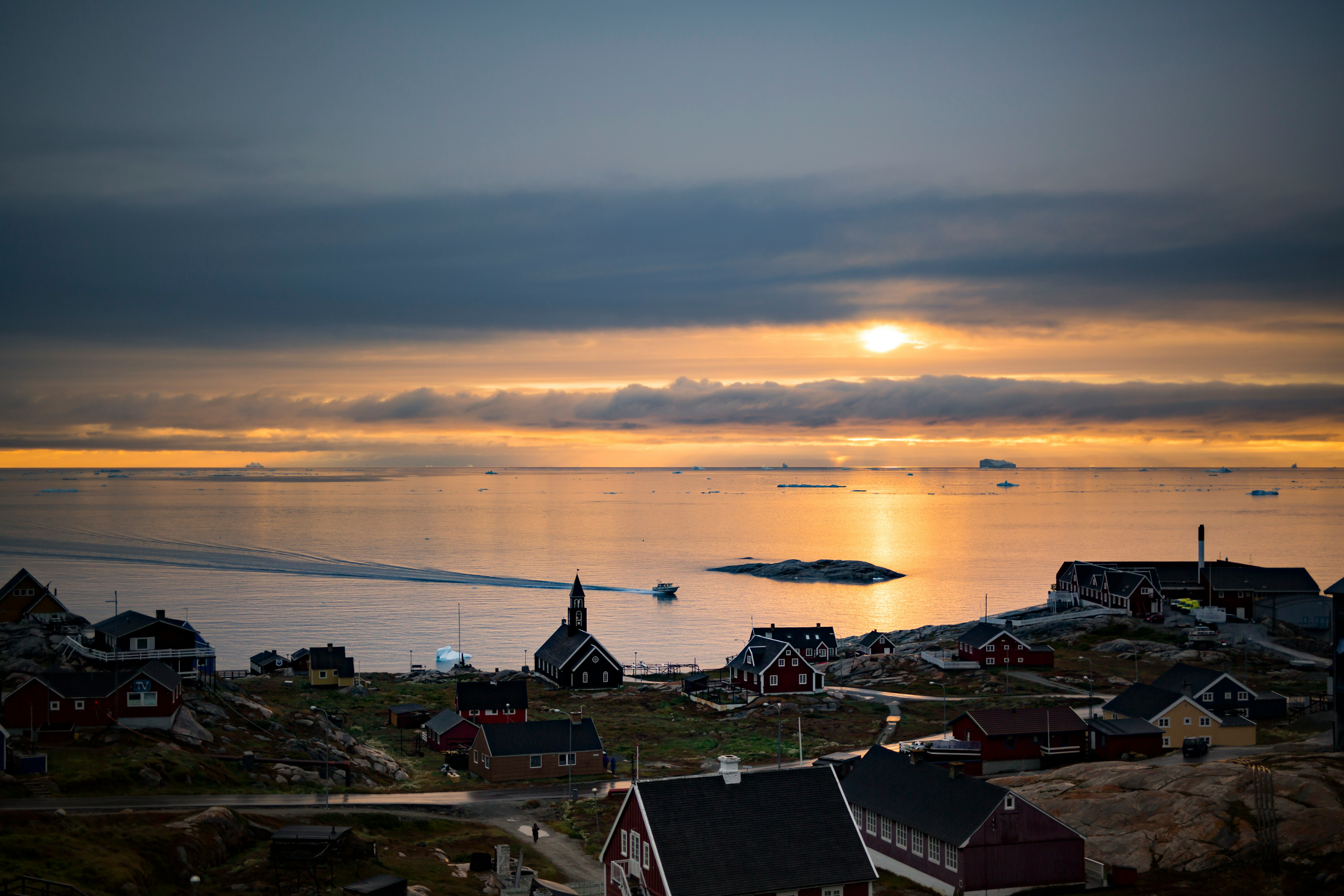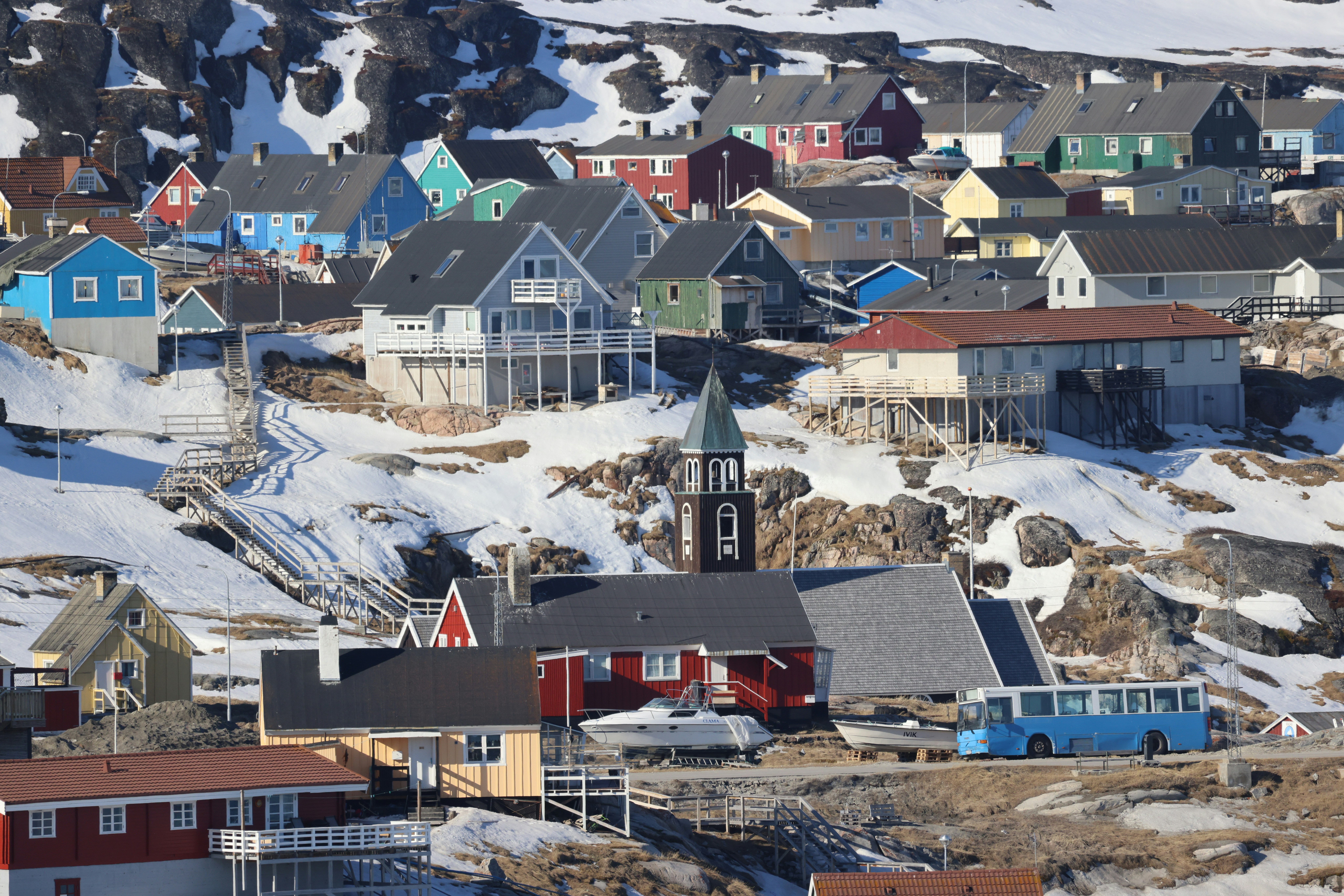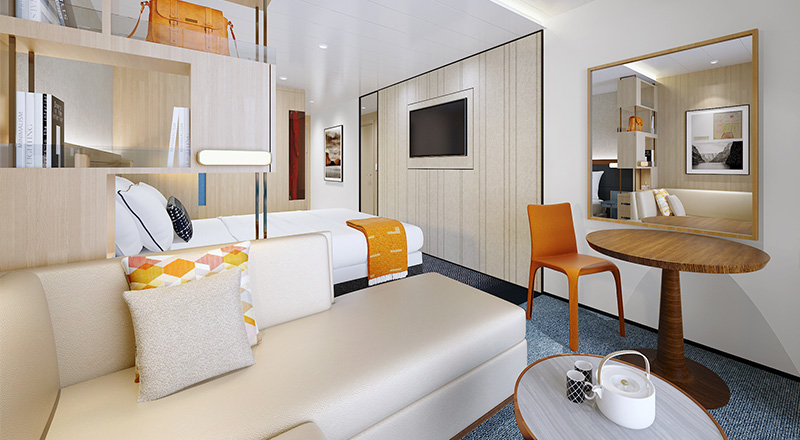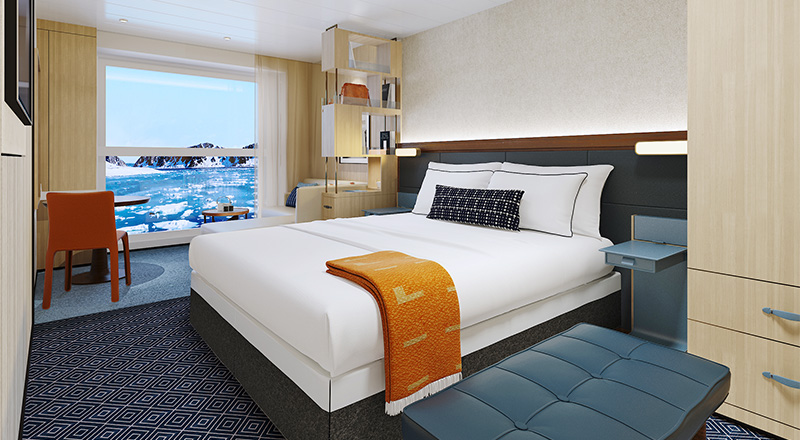
Into the Northwest Passage
Into the Northwest Passage
Cruise overview
WHY BOOK WITH US?
- ✔ The Deluxe Cruises’ team has extensive experience in ultra-luxury cruising.
- ✔ Call now to speak to our helpful and experienced Cruise Concierge team.
- ✔ Enjoy our Unique Deluxe Cruises Bonus for substantial savings.
- ✔ Our team will tailor your holiday to your exacting requirements.
- ✔ As agents, we work under the protection of each cruise lines ABTA / ATOL licences
About Nuuk (Godthaab)
Nuuk, meaning “the cape”, was Greenland’s first town (1728). Started as a fort and later mission and trading post some 240 kilometers south of the Arctic Circle, it is the current capital. Almost 30% of Greenland’s population lives in the town. Not only does Nuuk have great natural beauty in its vicinity, but there are Inuit ruins, Hans Egede’s home, the parliament, and the Church of our Saviour as well. The Greenlandic National Museum has an outstanding collection of Greenlandic traditional dresses, as well as the famous Qilakitsoq mummies. The Katuaq Cultural Center’s building was inspired by the undulating Northern Lights and can house 10% of Nuuk’s inhabitants.


About Nuuk (Godthaab)
Nuuk, meaning “the cape”, was Greenland’s first town (1728). Started as a fort and later mission and trading post some 240 kilometers south of the Arctic Circle, it is the current capital. Almost 30% of Greenland’s population lives in the town. Not only does Nuuk have great natural beauty in its vicinity, but there are Inuit ruins, Hans Egede’s home, the parliament, and the Church of our Saviour as well. The Greenlandic National Museum has an outstanding collection of Greenlandic traditional dresses, as well as the famous Qilakitsoq mummies. The Katuaq Cultural Center’s building was inspired by the undulating Northern Lights and can house 10% of Nuuk’s inhabitants.


About Itilleq
Itilleq is an idyllic little village located on a small island about ahalf a mile off the west coast of Greenland, and only about a mile north of theArctic Circle. It is one of the most picturesque villages in Greenland with itsquaint colorful houses surrounded by stunning rugged mountains and glaciers.Originally, the village of Itilleq was founded on another island in 1847, butwas later moved to its present location. The 100 people living here todaysurvive mainly on hunting and fishing, with a fish factory being the mainemployer.

About Ilulissat (Jakobshavn)
Known as the birthplace of icebergs, the Ilulissat Icefjord produces nearly 20 million tons of ice each day. In fact, the word Ilulissat means “icebergs” in the Kalaallisut language. The town of Ilulissat is known for its long periods of calm and settled weather, but the climate tends to be cold due to its proximity to the fjord. Approximately 4,500 people live in Ilulissat, the third-largest town in Greenland after Nuuk and Sisimiut. Some people here estimate that there are nearly as many sled dogs as human beings living in the town that also boasts a local history museum located in the former home of Greenlandic folk hero and famed polar explorer Knud Rasmussen.



About Uummannaq
In the iceberg-laden waters surrounding the remote community of Uummannaq it is common to see whales. This area of Greenland is also known for its huge basalt mountains, and the small hunting and fishing village of Uummannaq rests at the foot of the heart-shaped Uummannaq Mountain, a name that translates to mean “in the shape of a seal’s heart”. The town of over 1200 people has a granite church and the country’s most northerly ferry terminal. The economy of Uummannaq revolves largely around the halibut/fish-processing factory.


About Pond Inlet, Nunavut
Located in northern Baffin Island, Pond Inlet is a small, predo¬minantly Inuit community, with a population of roughly 1,500 inhabitants. In 1818, the British explorer John Ross named a bay in the vicinity after the English astronomer John Pond. Today Pond Inlet is considered one of Canada's "jewels of the North" thanks to several picturesque glaciers and mountain ranges nearby. Many archaeological sites of ancient Dorset and Thule peoples can be found near Pond Inlet. The Inuit hunted caribou, ringed and harp seals, fish, polar bears, walrus, narwhals, geese, ptarmigans and Arctic hares, long before European and American whalers came here to harvest bowhead whales. Pond Inlet is also known as a major center of Inuit art, especially the printmaking and stone carving that are featured in the town’s art galleries.


About Dundas Harbour, Devon Island, Nunavut
Dundas Harbour is located in the southeast of Devon Island, Canada’s 6th largest island. It is a forlorn but starkly beautiful spot. The island was first sighted by Europeans in 1616 by the English explorers Robert Bylot and William Baffin. But it did not appear on maps until after explorer William Edward Parry’s exploration in the 1820’s. Parry named it after Devon, England. In the local Inuktitut language, the place is called Talluruti, which translates as “a woman’s chin with tattoos on it.” This refers to the deep crevasses and streaks on Devon Island, which from a distance resemble traditional facial tattoos. On land there are remains of a Thule settlement dating back to 1000 A.D., including tent rings, middens and a gravesite. There are also much more recent remains a Royal Canadian Mounted Police outpost. The first post was established in 1924 to monitor and control illegal activities, such as foreign whaling, in the eastern entrance to the Northwest Passage. But conditions were so isolated and severe that the post was abandoned in 1933. It was reopened in 1945, but again closed, this time permanently, in 1951. Today, Devon Island is the largest uninhabited island in the world.

About Beechey Island, Nunavut
Beechey Island is a small island off the southwest coast of Devon Island, separated by a narrow waterway called the Barrow Strait. Captain William Edward Parry was the first European to visit the island in 1819. His lieutenant, Frederick William Beechey, named the island after his father, the artist William Beechey (1753–1839). Beechey Island played a significant role in the history of Arctic Exploration. During the winter of 1845-46, Sir John Franklin and his men camped on the island as part of their ill-fated quest to find the Northwest Passage. Mummified remains of three of Franklin’s crew were discovered, giving a better understanding of what happened before the disappearance of the expedition. In 1850 Edward Belcher used the island as a base while surveying the area. Later, in 1903, Norwegian explorer Roald Amundsen stopped at the island at the beginning of his successful voyage in search for the Northwest Passage. Subsequently, Beechey Island has been declared a "Territorial Historic Site" since 1975 by the Northwest Territories government

About Bylot Island, Nunavut
Bylot Island, off the northern end of Baffin Island has an area of 4,273 square miles, making it one of the largest uninhabited islands in the world. Cape Burney lies on the east coast of Bylot Island, and is used regularly by local Inuit during their hunting and fishing seasons. The island is named for the Arctic explorer Robert Bylot who was the first European to sight the island’s steep mountains, ice fields, sheer cliffs, snowfields and glaciers in 1616. A total of 74 species of Arctic birds thrive on this island. In fact, it is such an important nesting area that the entire island has been incorporated into the Sirmilik National Park, and the eastern part of the island is federally designated as the Bylot Island Migratory Bird Sanctuary. It is also a major nesting site for birds, including Thick-billed Murres, Black-legged Kittiwakes and Greater Snow Geese.

About Sisimiut (Holsteinsborg)
Located just north of the Arctic Circle, Sisimiut is the northernmost town in Greenland where the port remains free of ice in the winter. Yet it is also the southernmost town where there is enough snow and ice to drive a dogsled in winter and spring. In Sisimiut, travelling by sled has been the primary means of winter transportation for centuries. In fact, the area has been inhabited for approximately 4,500 years. Modern Sisimiut is the largest business center in the north of Greenland, and is one of the fastest growing Greenlandic cities. Commercial fishing is the lead economy in the town‘s thriving industrial base.



About Nuuk (Godthaab)
Nuuk, meaning “the cape”, was Greenland’s first town (1728). Started as a fort and later mission and trading post some 240 kilometers south of the Arctic Circle, it is the current capital. Almost 30% of Greenland’s population lives in the town. Not only does Nuuk have great natural beauty in its vicinity, but there are Inuit ruins, Hans Egede’s home, the parliament, and the Church of our Saviour as well. The Greenlandic National Museum has an outstanding collection of Greenlandic traditional dresses, as well as the famous Qilakitsoq mummies. The Katuaq Cultural Center’s building was inspired by the undulating Northern Lights and can house 10% of Nuuk’s inhabitants.


- Largest suite on board: 1,223 sq. ft. with a 792 sq. ft. private garden lounge area with badestamp
- All amenities of the Explorer Suite, plus:
- Priority stateroom access
- Floor-to-ceiling drying closet
- Four guaranteed priority reservations at each alternative restaurant (100 days prior to departure)
- First priority expedition activity reservations (107 days prior to departure)
- First priority booking of spa treatments (100 days prior to departure)
- Dinner & guided tour with ship officers (subject to availability)
- Large master bathroom, plus one guest bathroom
- Separate dining area/board room that seats six guests
- Private library, wine & music collections curated by Chairman Torstein Hagen
- And more; ask for details

- Size including Nordic Balcony & private veranda: 580 sq. ft.
- 11 AM stateroom access
- Floor-to-ceiling drying closet
- Priority expedition activity reservations (97 days prior to departure)
- Three guaranteed priority reservations at each alternative restaurant (90 days prior to departure)
- Priority booking of spa treatments (90 days prior to departure)
- Mini-bar with alcoholic beverages, soft drinks, water & snacks, replenished once daily
- In-suite binoculars, coffee & Marius-weave blanket
- Laundry, dry cleaning, pressing & shoe shine services
- Welcome bottle of champagne
- Exclusive access to shared Explorer Suite private garden lounge area

Size including Nordic Balcony: 322 sq ft
- 11 AM stateroom access
- Floor-to-ceiling drying closet
- Priority expedition activity reservations (87 days prior to departure)
- Three guaranteed priority reservations at each alternative restaurant (80 days prior to departure)
- Priority booking of spa treatments (80 days prior to departure)
- Mini-bar with alcoholic beverages, soft drinks, water & snacks, replenished once daily
- In-suite binoculars, coffee & Marius-weave blanket
- Laundry, dry cleaning, pressing & shoe shine services
- Bottle of champagne

Size including Nordic Balcony: 269 sq ft
- 1 PM stateroom access
- Floor-to-ceiling drying closet
- Priority expedition activity reservations (77 days prior to departure)
- Two guaranteed priority reservations at each alternative restaurant (70 days prior to departure)
- Priority booking of spa treatments (70 days prior to departure)
- Mini-bar with alcoholic beverages, soft drinks, water & snacks, replenished once daily
- In-suite binoculars, coffee & Marius-weave blanket
- Pressing & shoe shine services
- Bottle of champagne


Size including Nordic Balcony: 222 sq ft
- 2 PM stateroom access
- Floor-to-ceiling drying closet
- Priority expedition activity reservations (67 days prior to departure)
- One guaranteed priority reservation at each alternative restaurant (60 days prior to departure)
- Priority booking of spa treatments (60 days prior to departure)
- Mini-bar with soft drinks, water & snacks, replenished once daily
- In-suite binoculars, coffee & Marius-weave blanket

Size including Nordic Balcony: 222 sq ft
- 3 PM stateroom access
- Floor-to-ceiling drying closet
- Expedition activity reservations (60 days prior to departure)
- Mini-bar with soft drinks, water & snacks
- In-suite binoculars & Marius-weave blanket

Viking Octantis
First, we invented modern river cruising. Then, we redefined ocean cruising. Now, experience all the comfort and elegance of our award-winning fleet with an expedition ship built specifically to explore the world's most remote destinations and allow you to immerse yourself in these regions.

Ship Facts
| Launch Year | 2022 | ||||||
| Refit Year | |||||||
| Language | en | ||||||
| Gross Tonnage | 30105 | ||||||
| Length | 205 | ||||||
| Width | 21 | ||||||
| Currency | EUR | ||||||
| Speed | 18 | ||||||
| Capacity | 378 | ||||||
| Crew Count | 260 | ||||||
| Deck Count | 6 | ||||||
| Cabin Count | N/A | ||||||
| Large Cabin Count | N/A | ||||||
| Wheelchair Cabin Count | N/A | ||||||
| Electrical Plugs |
|
Deck A
- The Hangar
- Medical Center
- Embarkation
- Lifts

Deck 1
- The Hangar
- The Science Lab
- Manfredi's Restaurant
- The Restaurant
- Guest Services
- Lifts
- The Hide
- Bar

Deck 2
- The Aula
- Hair Salon
- Fitness Center
- The Nordic Spa
- Finse Terrace
- Expedition Central
- Nordic Balcony Staterooms
- Lifts

Deck 3
- The Aula (upper level)
- The Nordic Shop
- Travel Consultant
- The Shelter
- The Bow
- Deluxe Nordic Balcony
- Lifts

Deck 4
- Explorers' Lounge
- Bar
- Deluxe Nordic Balcony
- Nordic Junior Suite
- Nordic Penthouse
- Lifts

Deck 5
- Aquavit Terrace
- The Pools
- World Cafe
- Mamsen's
- Promenade Deck
- Bar
- The Living Room
- The Library
- Explorers' Lounge (upper level)

Deck 6
- Owner's Suite & Garden
- Explorer's Suite & Garden
- Open Deck
- Bridge
- Lifts

The World Cafe
Mamsen's
The Restaurant
Manfredi's
24-Hour Options
Innovative, light-filled spaces where comfort meets discovery.
Explorers' Lounge
The Pools
Aquavit Terrace
The Living Room
The Library
Finse Terrace